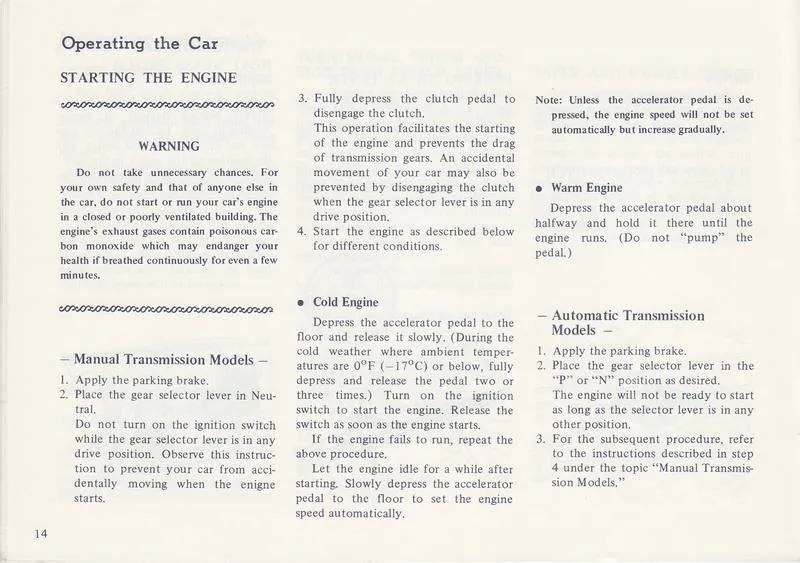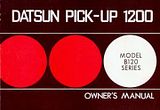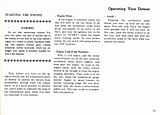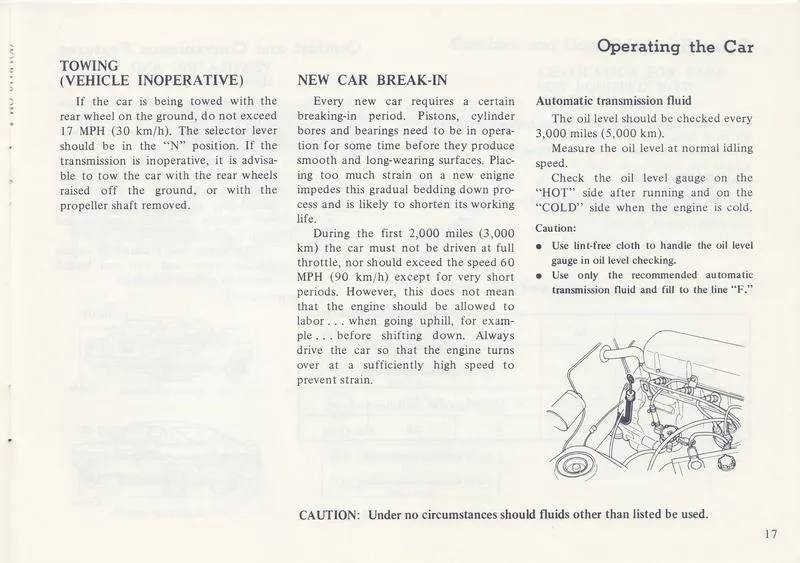<-- back to Owners manual
Operating the Car (or Operating Your Datsun) is a section in the Datsun 1200 owners manual.
Contents |
[edit]
Introduction
1972 USA Owners manual (Page 14 ... 18):
 Operating the Car
Operating the Car
WARNING
Do not take unnecessary chances. For your own safety and that of anyone else in the car, do not start or run your car's engine in a closed or poorly ventilated building. The engine's exhaust gases contain poisonous carbon monoxide which may endanger your health if breathed continuously for even a few minutes.
[edit]
Starting the Engine
See also: Choke Operation
1972 USA Owners manual (Page 14 ... 14):
 WARNING
WARNING
Do not take unnecessary chances. For your own safety and that of anyone else in the car, do not start or run your car's engine in a closed or poorly ventilated building. The engine's exhaust gases contain poisonous carbon monoxide which may endanger your health if breathed continuously for even a few minutes.
[edit]
Automatic Choke Car
[edit]
Manual Transmission Models
- Manual Transmission Models -
- Apply the parking brake.
- Place the gear selector lever in Neutral.
Do not turn on the ignition switch while the gear selector lever is in any drive position. Observe this instruction to prevent your car from accidentally moving when the enigne [sic] starts.- Fully depress the clutch pedal to disengage the clutch.
This operation facilitates the starting of the engine and prevents the drag of transmission gears. An accidental movement of your car may also be prevented by disengaging the clutch when the gear selector lever is in any drive position.- Start the engine as described below for different conditions.
- Cold Engine
Depress the accelerator pedal to the floor and release it slowly. (During the cold weather where ambient temperatures are 0ºF (-17ºC) or below, fully depress and release the pedal two or three times.) Turn on the ignition switch to start the engine. Release the switch as soon as the engine starts.
If the engine fails to run, repeat the above procedure.
Let the engine idle for a while after starting. Slowly depress the accelerator pedal to the floor to set the engine speed automatically.
Note: Unless the accelerator pedal is depressed, the engine speed will not be set automatically but increase gradually.
- Warm Engine
Depress the accelerator pedal about halfway and hold it there until the engine runs. (Do not "pump" the pedal.)
[edit]
Automatic Transmission Models
- Automatic Transmission Models -
- Apply the parking brake.
- Place the gear selector lever in the "P" or "N" position as desired.
The engine will not be ready to start as long as the selector lever is in any other position.- For the subsequent procedure, refer to the instructions described in step 4 under the topic "Manual Transmission Models."
[edit]
Engine Flooded
Slowly depress the accelerator pedal as far as it will go. Keep the pedal depressed until the engine is clear of excess fuel and is running smoothly. Do not "pump" the pedal.
- Engine Flooded
[edit]
Manual Choke Car
1974 B120 Owner's Manual (Page 13 ... )
WARNING
Do not take unnecessary chances. For your own safety and that of anyone else in the car, do not start or run your car's engine in a closed or poorly ventilated building. The engine's exhaust gases contain poisonous carbon monoxide which may endanger your health if breathed continuously for even a few minutes.
First, before you turn on the ignition switch, put the transmission gears in neutral to prevent the vehicle from accidentally moving when the engine starts. It is a good practice to depress the clutch pedal to eliminate the drag of the transmission gears while you start up, especially in cold weather.
- Engine Warm -
If the engine is relatively warm, you may not need to use the choke at all. Just press the accelerator pedal down about one-quarter of its travel to the floor, and turn the ignition key in the switch to "START", when the engine starts running under its own power, release the key and it will spring back to the "ON" position.
- Engine Cold (Cold Weather) -
With a cold engine, pull the choke control button out all the way, press the accelerator pedal down slightly, and then start the engine. As soon as the engine starts, push the choke control button in far enough to keep the engine running smoothly. Then push it in all the way when the temperature gauge pointer begins to move toward its normal operating range. Do not drive steadily with the choke control button pulled out. This may result in excessive fuel consumption.
- Avoid-
Pumping the accelerator pedal before you start up does not do any good. You will only flood the engine with gasoline and it will not start. In this case, push the choke control in all the way, and then press and hold the accelerator pedal to the floor while you operate the starter.
[edit]
Driving
[edit]
Manual Transmission
1972 USA Owners manual (Page 15 ... ):
 DRIVING WITH MANUAL TRANSMISSION
DRIVING WITH MANUAL TRANSMISSION
Appropriate speed range in each gear (MPH) Your car has a 4-forward and 1-reverse speed transmission controlled by a gear shift lever located on the floor.1st 0 to 25 2nd 10 to 45 3rd 20 to 70 4th Over 25
Be sure that you depress the clutch pedal completely while you are shifting gears to avoid clashing and chipping the transmission gears. For the same reason, shift to reverse only when the car is completely stopped.
At low speeds and in stop-and-go traffic, you will find the engine more responsive to acceleration when you downshift to a lower gear. Hill climbing is easier and reduces the possibility of stalling the engine if you shift to 3rd or 2nd gear.
To maintain safe speeds on steep down-grades, and to help safe brakes, shift to 3rd or 2nd before you start.
Do not rest your foot on the clutch pedal except when you are ready to shift gears. A clutch can become prematurely worn or completely ruined by riding it. Slipping the clutch by releasing the pedal just enough to hold the car on a hill will eventually cause clutch wear and damage.
In case of normal acceleration, it is most economical to change gears at the lower speeds, considering fuel consumption. However, when quick acceleration is required, it is proper to change at the higher speeds.
[edit]
Automatic Transmission
1972 USA Owners manual (Page 16 ... ):
 DRIVING WITH AUTOMATIC TRANSMISSION
DRIVING WITH AUTOMATIC TRANSMISSION
GEAR SELECTOR
The pointer on the selector indicates the transmission gear range. The selector lever is mounted on the floor.
When you are ready to drive, move the selector lever from "P" or "N" to the desired drive position.
GEAR RANGES
"P" Parking: Supplements the parking brakes by locking the transmission. The engine can be started in this range. Never use "P" while the car is in motion, Apply the parking brake while the gear is in this range.
"R" Reverse: Use only when the car has been stopped completely. Pull the selector lever toward you before moving into "R."
"N" Neutral: Use when the car is standing for a prolonged period with the engine running, The engine can be started in this range.
"D" Drive: For most city and highway driving. Press down the accelerator pedal as needed to start the car moving in first gear. Transmission will automatically upshift to second and third gears. You can get quick power and acceleration to pass another moving car quickly or to climb hills by pressing the accelerator pedal fully to the floor to down shift from high to second or low gear at speeds up to 75 MPH (120 km/h).
"2" Second: For driving slowly in heavy city traffic or on mountain roads where more precise speed control is desirable. Use it also when climbing long grades, and for "engine braking" when descending moderately steep grades. To prevent excessive engine speed do not exceed 75 MPH (120 km/h) in this range.
"1" Low: For driving up very steep hills and for "engine braking" at low speeds when going downhill, To prevent excessive engine pseed do not exceed 38 MPH (60 km/h) in this range.
HOW TO OPERATE SELECTOR LEVER
The selector lever should first be pushed down when it is shifted in the arrow directions "->." This prevents damage to the automatic transmission by eliminating an unintentional shift into any of the driving positions indicated by the arrow.
The lever will shift directly into any of the driving positions indicated by the arrows "5."
[edit]
Towing
See also: Towing
1972 USA Owners manual (Page 17 ... ):
 TOWING (VEHICLE INOPERATIVE)
TOWING (VEHICLE INOPERATIVE)
If the car is being towed with the rear wheel on the ground, do not exceed 17 MPH (30 km/h). The selector lever should be in the "N" position. If the transmission is inoperative, it is advisable to tow the car with the rear wheels raised off the ground, or with the propeller shaft removed.
[edit]
New Car Break-in
See also: Automatic Transmission Fluid
1972 USA Owners manual (Page 17 ... ):
 NEW CAR BREAK-IN
NEW CAR BREAK-IN
Every new car requires a certain breaking-in period. Pistons, cylinder bores and bearings need to be in operation for some time before they produce smooth and long-wearing surfaces. Placing too much strain on a new enigne [sic] impedes this gradual bedding down process and is likely to shorten its working life.
During the first 2,000 miles (3,000km) the car must not be driven at full throttle, nor should exceed the speed 60 MPH (90 km/h) except for very short periods. However, this does not mean that the engine should be allowed to labor ... when going uphill, for example ... before shifting down. Always drive the car so that the engine turns over at a sufficiently high speed to prevent strain.
Automatic transmission fluid
The oil level should be checked every 3,000 miles (5,000 km).
Measure the oil level at normal idling speed.
Check the oil level gauge on the "HOT" side after running and on the "COLD" side when the engine is cold.
Caution
- Use lint-free cloth to handle the oil level gauge in oil level checking.
- Use only the recommended automatic transmission fluid and fill to the line "F."
CAUTION: Under no circumstances should fluids other than listed be used.
¤

![[Datsun 1200 encyclopedia]](/wiki/upload/wiki.png)








